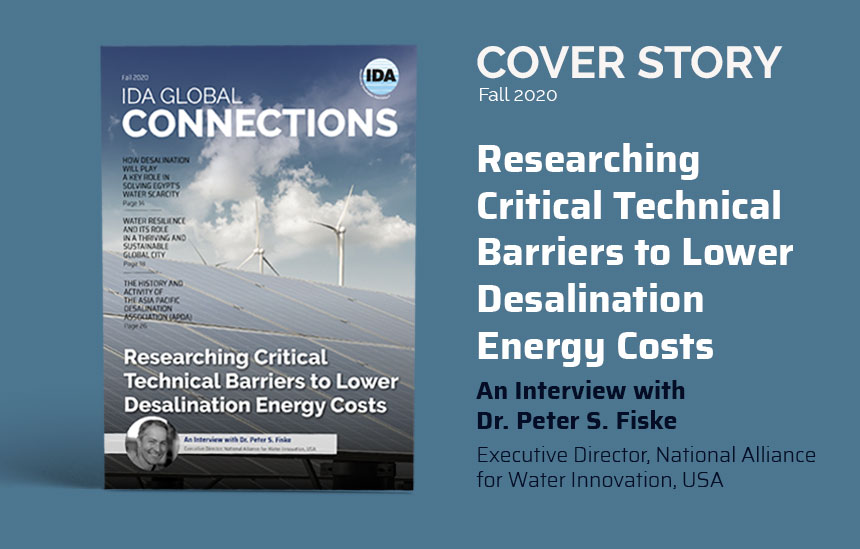Published on IDRA Global Connections Fall 2020 Issue
An Interview with Dr. Peter Fiske, Executive Director of the US National Alliance for Water Innovation (NAWI)
What has been the biggest gap in US advanced water treatment research identified by NAWI? Does this have international applications?
NAWI identified 6 key challenges in water treatment research, all of which, I think, have international applications:
- Autonomous systems: we need to improve the tools and technologies that allow our treatment systems to run more reliably and efficiently and reduce the burden on our operators. Better sensors, models, and adaptive process control systems are needed.
- Precision Separations: we need to develop water treatment systems that enable us to target specific contaminants or solutes, and enable us to tailor water treatment to achieve specific fit-for-purpose applications.
- Resilient Systems: we need innovations that enable our water treatment plants to be more flexible and nimble – able to seamlessly adjust to changes in input water chemistry and water volume.
- Process Intensification: we need new and hybrid treatment processes that can combine multiple steps into a single process – lowering plant sizes and enabling us to pack more treatment in smaller packages.
- Modular Systems: we need treatment technologies that are inherently modular (as RO is today) so that we can speed the time of design and fabrication rather than relying on bespoke designs and custom fabrication.
- Electrified Treatment Systems: electricity is getting very cheap, and our water systems can benefit by pushing treatment toward all-electric processes and reducing the reliance on chemical inputs that may have a significant GHG footprint. On-site generation of treatment chemicals and technologies that can transform waste products back into valuable materials and reagents would lower cost and improve resilience.
Can non-US organizations participate in NAWI’s research program?
Absolutely! We already have several international companies that have joined the NAWI Alliance and we welcome participation from across the ecosystem of water treatment.
Does NAWI fit into a larger strategy in the US to overcome water scarcity? How do these efforts address the energy water nexus, environmental sustainability, and societal implications?
Yes. NAWI is one of five pillars in the U.S. Department of Energy’s Water Security Grand Challenge (https://www.energy.gov/water-security-grand-challenge/water-security-grand-challenge), a set of 5 challenges that, if collectively tackled, can address our nation’s needs for reliable,
resilient water supplies for the 21st Century. Many other countries would probably find resonance with the priorities expressed in WSGC.
How can the international desalination community help NAWI be successful? What is NAWI doing that will make the international desalination community more successful?
Thank you so much for asking that question! The number one thing we need from the international desalination community is: engagement. We need leaders in the desalination field internationally to join the NAWI Alliance, attend our (free) annual meeting, and participate in our webinar
programs. Once the coronavirus pandemic has been successfully managed and it is safe to travel again, we hope that NAWI researchers can travel to leading desalination facilities and research centers abroad and learn, first hand, how technology pioneers are lowering the cost and increasing the reliability and adoption of desalination.
The US is relatively new in applying large-scale seawater desalination. What are some of the lessons learned internationally that would be of value in setting the NAWI research agenda and in the research itself?
Some of the most important international lessons are not technological but rather cultural and regulatory. Ocean desalination in the U.S. is still viewed as high-energy and high-cost, even though costs have fallen dramatically and unit process improvements have made desalination one of the most energy efficient chemical processes ever developed. I think one very valuable area of research to address these concerns is showing how desalination can provide climate-resilience to our communities and our industries. A number of countries outside the U.S. have recognized that, and I am hopeful that the U.S. will too.
What are three major outcomes expected from the US government’s investment and how is NAWI measuring success?
We will consider ourselves successful if we achieve the following:
1. We develop a portfolio of new and improved desalination processes and systems that lower the cost and energy of desalination such that we
can economically treat “non-traditional” waters such as wastewater and brackish groundwater at a cost and total economic value similar to the marginal water cost in most communities.
2. We provide the research community with new tools and data sets to drive innovation
3. We produce a new generation of water treatment innovators who start their careers in research, industry or in the operations environment and continue the innovation tradition NAWI has started.
We have been hearing about pipe parity being an important metric in measuring research success. Can you help our readers understand why this is important to our community?
Pipe-parity is the goal that the DOE has set out for NAWI: lowering the cost and energy of desalination and associated water treatment processes so that “nontraditional waters” – source waters that we presently don’t use because treatment is not economical – can become a viable marginal supply. The concept stems from the DOE’s successful program to help renewable energy to achieve “grid-parity” – cost and economic value comparable to today’s current (largely fossil-fuel-based) energy generation methods. After decades of investments, renewable energy is now at grid-parity in much of the world. DOE has a similar hope for desalination with its investment in NAWI.

